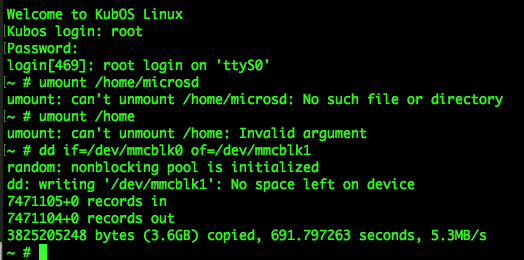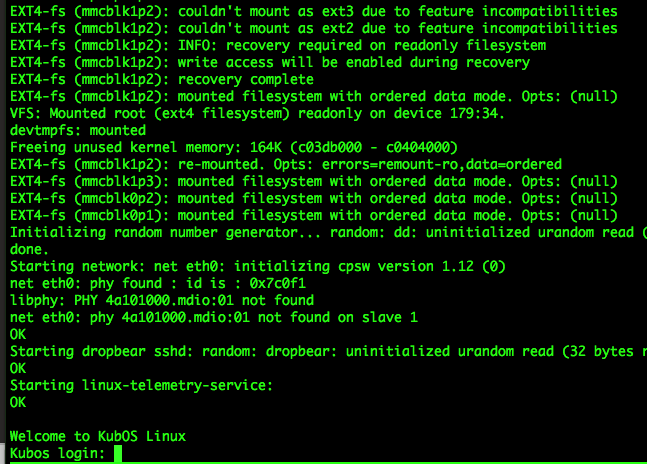Installing Kubos Linux on a Beaglebone Black¶
Overview¶
This document covers the steps required to install Kubos Linux onto a Beaglebone Black.
Reference Documents¶
Beaglebone Documentation¶
Kubos Documentation¶
- Getting Started with KubOS and the Kubos SDK - Basic tutorial for creating your first Kubos SDK project
- Kubos SDK Cheatsheet - Overview of the common Kubos SDK commands
- Using Kubos Linux - General guide for interacting with Kubos Linux
- Working with the Beaglebone Black - Guide for interacting with BBB-specific features
- Building Kubos Linux for the Beaglebone Black - Steps to build Kubos Linux
Components¶
The Kubos Linux installation process is composed of two high-level steps:
- Flashing the eMMC
- Flashing the microSD card
To perform a full default installation, two files are needed:
- A Kubos Linux SD card image
- An aux_sd image
All of these files can be obtained from our Kubos Linux Releases page on GitHub
Download the latest KubOS-v{version}.tar.gz file and then unzip the files for the Beaglebone Black. They’re located in the KubOS-v{version}/Beaglebone-Black folder.
Note
The Beaglebone Black can also be used as a development board for the Pumpkin MBM2. If you would like to use it for this purpose, please follow the Installing Kubos Linux on a Pumpkin Motherboard Module 2 instructions instead.
Pre-Requisites¶
- Obtain an SD card that is at least 4GB.
Note
The Kubos Linux SD images are created for a 4GB SD card. The image can be applied to a larger SD card, but the resulting system will still only have 4GB of space available to it.
- Install Etcher. Other software to flash SD cards does exist, but Etcher is the Kubos software of choice.
- Obtain the SD card images
Install the eMMC Image¶
Flash the SD Card¶
Using Etcher:
- Select the Kubos Linux image to flash
- Make sure the SD card device is correct (may be auto-detected if there is only one SD card present in your system.)
- Click the “Flash!” button to start the flashing process

Etcher Setup
It should take roughly 10 minutes for a 4GB image to be loaded onto an SD card.
Once the program has finished successfully, the SD card is ready to be inserted into the Beaglebone Black’s microSD slot.
Boot into U-Boot¶
Note
These instructions should work whether you’re currently running Kubos Linux or some other Linux distribution.
We now want to overwrite the eMMC, so we’ll need to use U-Boot in order to boot Kubos Linux from the SD card.
You’ll need to establish a serial connection with the board in order to connect to the console.
Hold down any key while the board is booting. This will exit out of the auto-boot and bring up the CLI.
U-Boot 2016.09 (Jul 17 2017 - 11:43:29 -0500)
I2C: ready
DRAM: 512 MiB
MMC: OMAP SD/MMC: 0, OMAP SD/MMC: 1
Net: cpsw, usb_ether
Hit any key to stop autoboot: 0
U-Boot>
Copy/paste these commands:
setenv bootargs console=ttyS0,115200 root=/dev/mmcblk0p2 ext4 rootwait; fatload mmc 0:1 ${fdtaddr} /beaglebone-black.dtb; fatload mmc 0:1 ${loadaddr} /kernel; bootm ${loadaddr} - ${fdtaddr}
This will cause the board to load Kubos Linux off of the microSD card, allowing us to flash the eMMC.
Flash the eMMC¶
To flash the eMMC, log into the board and then run these commands:
$ umount /home/microsd
$ umount /home
$ dd if=/dev/mmcblk0 of=/dev/mmcblk1

It is possible that you will see some errors when you try to unmount the directories.
That’s likely not a problem.
At some point, You may see an informational message,
random: nonblocking pool is initialized.
This message can be safely ignored.
The four status LEDs on the board should start flashing in a random pattern. This indicates that the eMMC is currently being flashed.
The process should take roughly ten minutes, after which the LEDs should return to normal, with one LED blinking to indicate a successfully running Kubos Linux system.
The system will complain that there is no space left on the device, however this message
can be ignored.
To explain: the eMMC is 4GB, but a small portion is set up as read-only and
dedicated to boot-time processing. That area means the contents of the 4 GB
SD card will be larger than the writeable area of the eMMC. The
No space left on device message will be issued but is not an error.
After this has completed, shutdown and de-power the system.
Install the Auxiliary Image¶
Re-Flash the SD Card¶
Now flash the microSD card with the auxiliary SD card image (aux-sd.img). This image contains the
Kubos Linux upgrade partition and the second user data partition.
Once the flash process has completed, put the card back into the microSD slot and boot up the system.

You will see messages as the data partitions are mounted. For example:
EXT4-fs (mmcblk0p2): couldn't mount as ext3 due to feature incompatibilities.
While they may seem like errors, they are a normal part of the boot process as the system detects the partition file type. If there are actual issues mounting a partition, the resulting error message will look like this:
mount: can't find PARTUUID=41555820-02
This example message is given when the system is unable to find the axilliary SD card’s second partition. This might be due to no microSD card being present, or the microSD card not being properly flashed with the auxilliary SD image.
If you see no such errors, the installation process is now complete.
Using Kubos Linux¶
For information on how to create and run applications on your new Kubos Linux system, see the Using Kubos Linux and Working with the Beaglebone Black guides.